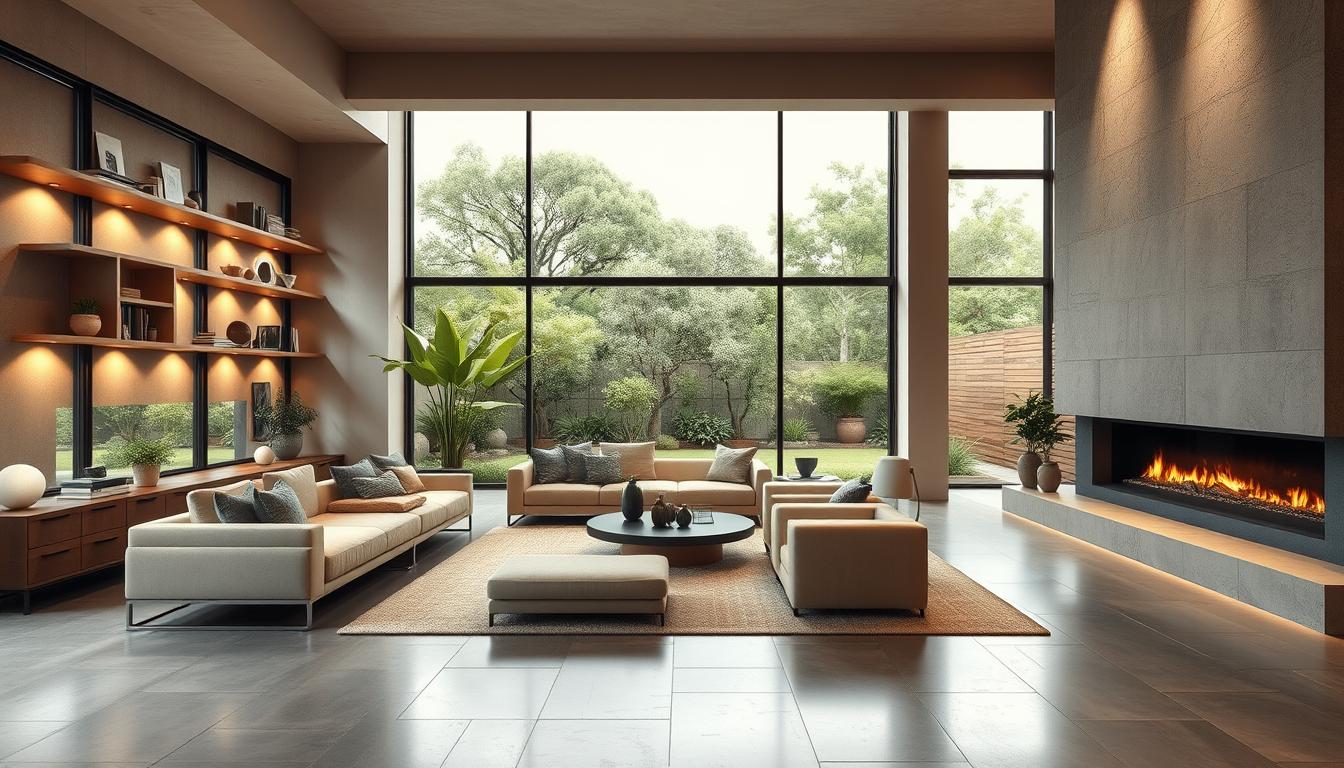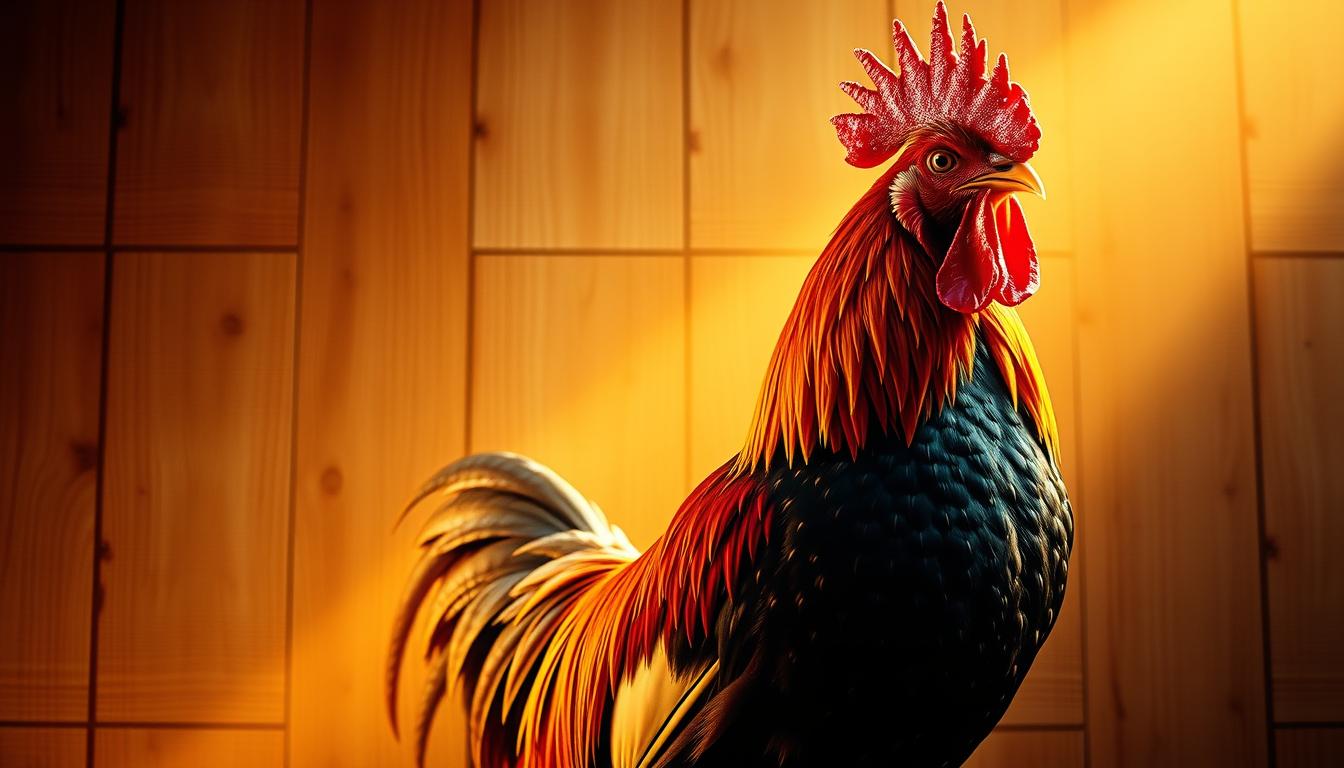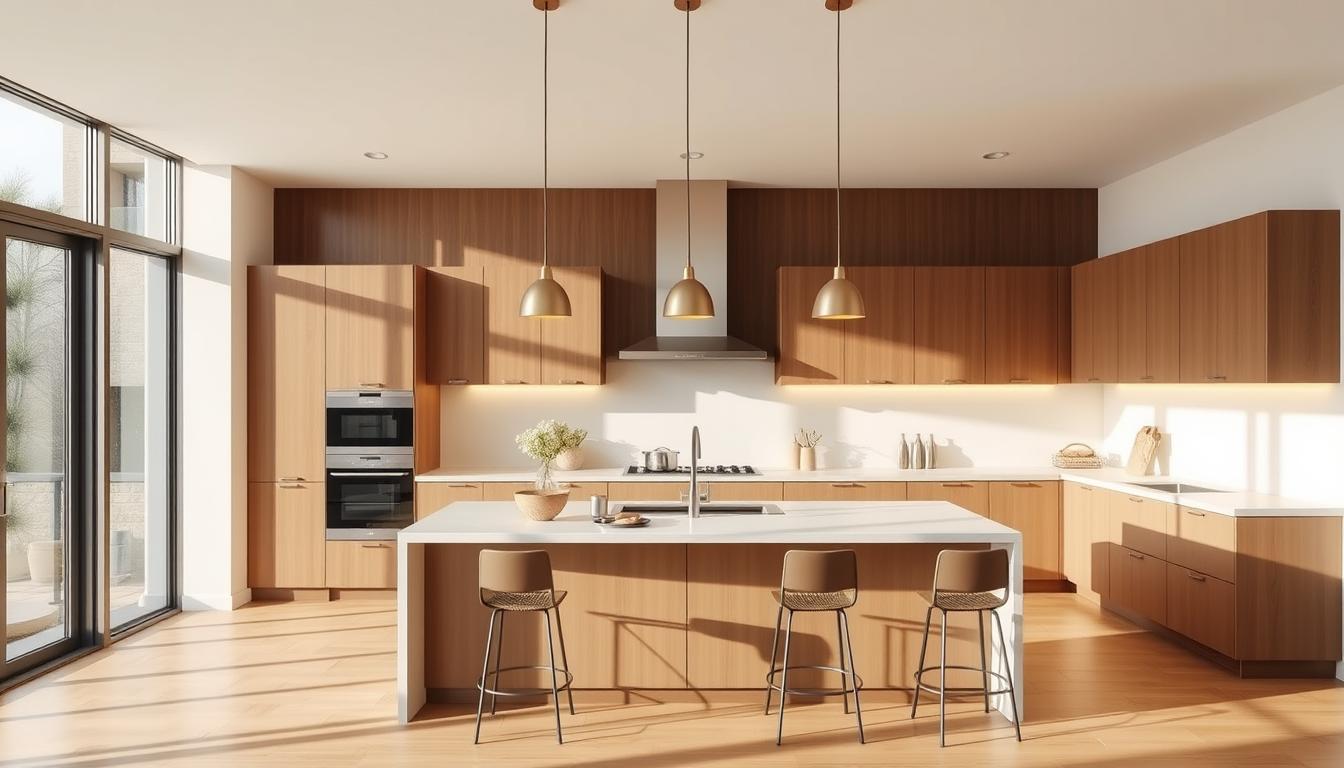As we enter 2023, the world of interior design is changing. We’re seeing a big move towards sustainability, bold looks, and mixing old with new. People want their homes to be better for the planet.
Leading these changes are modern home decor ideas that use natural colors, vintage touches, and tech. If you want to update your home, our top home interior design tips will help inspire and guide you.
Key Takeaways
- Sustainability is a key aspect of 2023’s interior design trends.
- Bold kitchens are making a statement with unique designs.
- Earthy elements and vintage-inspired decor are gaining popularity.
- Smart technology is being integrated into modern home decor.
- These trends are redefining the way we live and interact with our living spaces.
Embracing Earthy Tones in Our Spaces
Choosing earthy tones in our homes is more than a design trend. It’s a way to make our living spaces more sustainable and peaceful. As we explore home interior design, it’s clear that earthy tones are here to stay.
Earthy tones make our homes feel warm and welcoming. They invite us to relax and enjoy our surroundings. This trend celebrates the beauty of nature by bringing it inside.
Warm Neutrals vs. Bold Colors
Earthy tones balance warm neutrals and bold colors. Neutrals like beige, taupe, and soft gray calm our rooms. Bold colors like terracotta, sienna, and umber add depth and character.
Mixing warm neutrals and bold colors creates a lively space. For example, a beige wall with terracotta accents adds color and coziness.
Popular Shades for 2023
Here are the top earthy tones for 2023:
| Shade | Description | Best Used For |
|---|---|---|
| Terracotta | A warm, earthy red tone | Accent walls, decorative pieces |
| Sienna | A rich, earthy brown tone | Furniture, flooring |
| Umber | A deep, cool brown tone | Woodwork, decorative accents |
How to Incorporate Earthy Tones
To add earthy tones to your home, try these tips:
- Start with a neutral base: Use warm neutrals on walls and floors for a calm start.
- Add bold accents: Use bold earthy tones in furniture, rugs, and decor.
- Bring in natural textures: Add wood, stone, and plants for depth and texture.
By embracing earthy tones, we make our homes more sustainable, welcoming, and in tune with nature.
Biophilic Design: Bringing Nature Indoors
Biophilic design is changing how we see our homes by mixing the outdoors with the indoors. As we look for green interior design, adding natural elements to our homes is key. This approach not only makes our homes look better but also improves our health by connecting us to nature.
Benefits of Natural Elements
Adding natural elements to our homes offers many benefits, including:
- Improved air quality
- Enhanced mental health and well-being
- Increased productivity
- Aesthetic appeal that adds warmth and character to our spaces
By bringing nature inside, we make our living spaces more balanced and harmonious. Natural materials like wood and stone add texture and depth. This makes our homes feel more welcoming and organic.
Popular Plants for Home Interiors
Plants are key in biophilic design, as they clean the air and add beauty to our homes. Some top picks for home decor include:
- Snake Plants: They need little care and grow well in low light.
- Peace Lilies: They’re elegant and good at cleaning the air.
- Spider Plants: Easy to care for and versatile, perfect for hanging baskets or pots.
Creating Indoor-Outdoor Flow
To get the most from biophilic design, it’s important to blend indoor and outdoor spaces. This can be done by:
- Using big windows and sliding glass doors to link indoor and outdoor areas.
- Adding outdoor elements, like gardens or water features, to our design.
- Choosing materials and finishes that work well in both indoor and outdoor spaces.
By merging indoor and outdoor spaces, we create a more whole and relaxing living environment. This promotes well-being and helps us unwind.
Multifunctional Spaces: Adapting to Modern Life
Modern life keeps changing, and our homes need to adapt. With more people working from home, our living spaces must serve many purposes. They need to be places for work, play, and personal care.
Designing for Flexibility
Creating flexible spaces is key. We should pick layouts and furniture that can change easily. For example, a living room can become a home office with a murphy desk or a storage ottoman.
Furniture Choices that Maximize Space
The right furniture is vital for a space’s function. Choosing multifunctional furniture like a sofa bed or a coffee table with storage helps a lot. For more ideas, check out The Decor Journal India for transformable interior designs.
Creating Cozy Work-from-Home Areas
With more remote work, having a cozy home office is crucial. Set up a corner with good lighting, comfy chairs, and few distractions. Adding minimalist home interiors keeps the space tidy and focused.
By using these tips, we can make homes that are both beautiful and practical. As we follow the latest trends, multifunctional spaces will be essential in interior design’s future.
Sustainable and Eco-Friendly Materials
The move towards eco-friendly interior design is more than a trend. It’s a big change that’s reshaping how we decorate our homes. As we care more about the planet, we’re picking materials that are good for the environment.
Importance of Sustainable Design
Sustainable design is great for the planet and makes our homes better. By picking eco-friendly materials, we cut down on waste and make our homes healthier. Sustainable design practices mean choosing materials that are recycled or come from sustainable sources.
Also, sustainable design boosts our well-being. For example, natural materials can make the air in our homes cleaner. And using green lighting can make us happier and more productive.
Trending Eco-Friendly Materials
There are many eco-friendly materials that are popular in home design. These include:
- Bamboo: A fast-growing plant that’s great for floors and furniture.
- Recycled Glass: Used in countertops and decor, it adds a special touch to our homes.
- Sustainably Sourced Wood: Wood that’s certified by groups like the Forest Stewardship Council (FSC) ensures it comes from well-managed forests.
Tips for Sustainable Home Décor
Adding sustainable touches to our home decor is easy. Here are some tips:
- Choose furniture made from sustainable materials or made in eco-friendly ways.
- Use lights and appliances that save energy to cut down on power use.
- Pick decor items made from recycled or upcycled materials for a unique look.
By using sustainable and eco-friendly materials, we help the planet and make our homes beautiful and lasting.
Vintage and Retro Influences
Vintage and retro elements are adding a touch of nostalgia and sophistication to modern homes. This reflects a shift in luxury interior trends. As we embrace the latest home decor trends, incorporating vintage pieces and retro styles into our interiors is becoming increasingly popular.
Mixing Vintage with Modern
Blending vintage with modern styles requires a thoughtful approach. This creates a harmonious and stylish space. Here are some tips to achieve this balance:
- Start with a neutral background to let vintage pieces be the focal point.
- Mix vintage furniture with modern decor to create an interesting contrast.
- Use vintage accessories, such as vintage lamps or decorative items, to add character.
Popular Retro Styles Making a Comeback
Several retro styles are making a comeback in interior design trends. Some of the most popular include:
| Retro Style | Characteristics |
|---|---|
| Mid-Century Modern | Clean lines, organic shapes, and functional design. |
| Art Deco | Geometric patterns, metallic accents, and luxurious materials. |
| Retro Minimalism | Simple, bold colors, and graphic patterns. |
For more inspiration on retro home decor ideas, visit Home and Gardens.
Thrift Shopping for Unique Finds
Thrift shopping is an excellent way to discover unique vintage pieces. These can add character to your home. Here are some tips for successful thrift shopping:
- Know what you’re looking for to avoid impulse buys.
- Inspect items carefully for damage or needed repairs.
- Don’t be afraid to negotiate prices.
By incorporating vintage and retro elements into our homes, we can create spaces that are stylish and rich in history. This reflects the latest interior design trends.
Smart Technology in Home Design
Smart technology is changing how we live, making our homes more comfortable and efficient. It’s a key part of modern home decor ideas. As we follow the latest trends, adding smart home devices is crucial.
Integrating Smart Home Devices
Smart home devices make our lives easier by controlling our homes. They let us control things like lighting, temperature, and security from our phones or tablets. This gives us unmatched convenience. Some popular devices include:
- Smart thermostats that learn your temperature preferences and adjust
- Smart lighting systems that mimic a natural day-night cycle
- Smart security cameras that send alerts and monitor in real-time
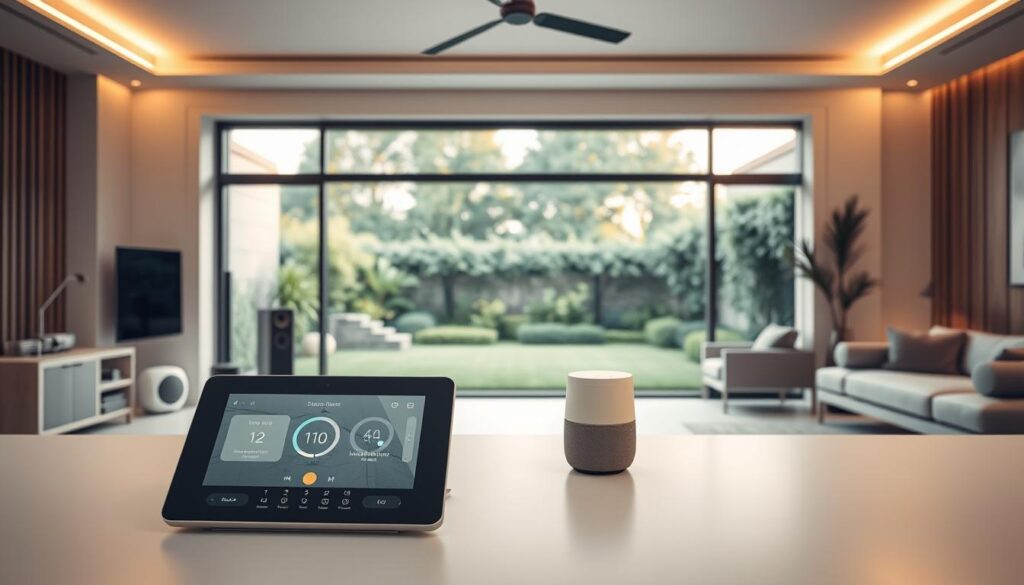
Future Trends in Home Automation
The future of home automation is exciting, with AI and IoT leading the way. We’ll see systems that learn our habits and preferences. This will make our homes even more comfortable and efficient. Some trends to look out for include:
- Voice-controlled homes that respond to our commands
- Predictive maintenance that spots issues before they happen
- Smart grids and energy-harvesting for better energy use
Enhancing Comfort and Convenience
Smart technology is not just about function; it’s about comfort and convenience too. It helps us create a luxurious and relaxing home. For example, smart lighting can set the mood for a cozy evening. Smart thermostats keep our homes at the perfect temperature.
As we explore smart technology in home design, it’s clear it’s shaping luxury interior trends. By embracing these trends, we can make homes that are beautiful, intelligent, and meet our needs.
Textured Finishes: Elevating Our Interiors
Textured finishes are becoming key in interior design. They turn flat spaces into engaging, multi-dimensional environments. Texture makes a big difference in how we experience a room.
Types of Textural Elements
There are many types of textures, from natural materials like wood and stone to man-made ones like textured glass and metallic finishes. Mixing these can add depth and interest to any room.
- Natural materials: wood, stone, brick
- Manufactured materials: textured glass, metallic finishes
- Fabric and textiles: rugs, throw blankets, upholstered furniture
By combining different textures, we can create a look that’s visually appealing and reflects our style. It also fits with the latest home decor trends.
Best Practices for Layering Textures
Layering textures well is all about balance and harmony. Here are some tips:
- Start with a main texture and add contrasting ones for interest.
- Mix materials and textures to add depth.
- Use textiles like rugs and throw blankets for warmth and coziness.
Following these tips helps us achieve a harmonious mix of textures. This elevates our spaces and fits with modern decor ideas.
Visual Impact of Textured Walls
Textured walls can change a room’s feel, adding a unique element that draws the eye and invites touch. Whether it’s textured paints, wallpaper, or natural materials, textured walls can be a focal point.
| Texture Type | Visual Impact | Design Tip |
|---|---|---|
| Textured Paint | Adds subtle depth and visual interest | Use on accent walls to create a focal point |
| Natural Stone | Brings in a natural, earthy element | Pair with smooth surfaces for contrast |
| Textured Wallpaper | Creates a dramatic, dimensional effect | Choose a design that complements your decor |
Using textured finishes in our interiors is more than following trends. It’s about creating spaces that are rich in character and sensory experience.
“The use of texture in interior design is a powerful tool for creating spaces that are not only visually appealing but also tactilely engaging.” – Interior Design Expert
Minimalism with a Personal Touch
Minimalist home interiors are all about finding a balance. It’s not just about clean lines and little decor. It’s about making a space that feels like home and is inviting.
Balancing Simplicity and Personalization
Finding the right balance means choosing carefully. We pick a few special items that show our style and fit the minimalist look.
To make a minimalist space feel like you, add unique decor. Think about artwork or vintage furniture that tells a story or makes you feel something.
How to Curate a Minimalist Space
Creating a minimalist space needs thought. Here’s how to do it:
- Begin with a clean space and get rid of things you don’t need.
- Pick a few key pieces that show your style.
- Use neutral colors to keep things calm.
- Add natural textures for depth and interest.
Decor Pieces that Reflect Our Style
The right decor can make a minimalist space truly yours. Think about these:
| Decor Piece | How it Adds Personality |
|---|---|
| Artwork | It adds a personal touch and makes things interesting. |
| Vintage Furniture | It brings character and history to the space. |
| Personal Mementos | It makes the space feel lived-in and meaningful. |
By adding these elements, we can make a minimalist space that’s both beautiful and personal.
“The best way to get started is to quit talking and begin doing.”
This quote captures the essence of creating a minimalist space with a personal touch. It’s about taking action and making choices that reflect our style and values.
Statement Lighting: Making a Bold Impact
Statement lighting is changing how we decorate our homes. It can completely change a room’s feel. Homeowners are now choosing bold, unique lights to stand out.
It’s not just about light; it’s about making a statement. A beautiful chandelier or a sleek lamp can make a room special. It adds class and sophistication.
Types of Statement Light Fixtures
There are many statement lights to choose from. Here are a few:
- Chandeliers: Great for a dramatic look, they come in many styles.
- Pendant Lights: Add elegance to kitchens, dining areas, or bedrooms.
- Sculptural Fixtures: For those who like something different, these offer a unique look.
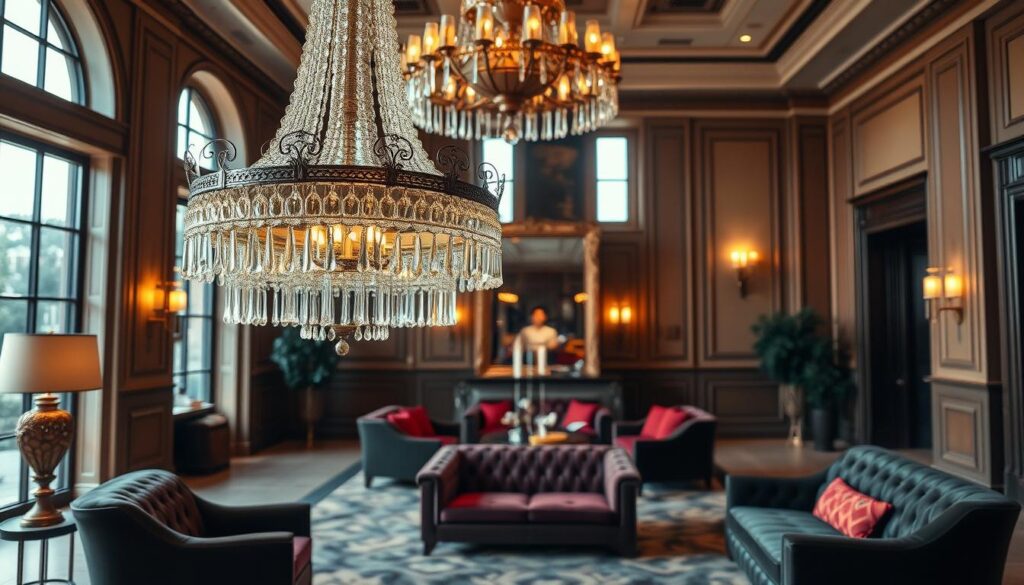
Setting the Mood with Lighting
Lighting sets the mood of a room. The right light can make it warm and cozy or bright and lively. Here’s how to choose:
| Mood | Lighting Type | Effect |
|---|---|---|
| Warm and Cozy | Soft, warm-toned lamps | Creates a relaxing ambiance |
| Energizing | Bright, cool-toned overhead lighting | Increases alertness and energy |
| Dramatic | Dimmable, colored lighting | Adds a touch of drama and sophistication |
Unique Ideas for Lighting Arrangements
To really stand out with lighting, try unique setups. Here are some ideas:
- Layer different lights for depth and interest.
- Use LED strip lights for a modern glow.
- Add warmth with candles or lanterns.
Embracing statement lighting can make our homes more beautiful. It shows off our style and personality.
The Revival of Art Deco Elements
Art Deco is back in modern homes, thanks to its timeless appeal. Its geometric patterns and metallic accents add glamour and luxury. As we look at interior design trends, Art Deco’s influence is clear.
Key Characteristics of Art Deco Design
Art Deco stands out with bold shapes, metallics, and ornate details. Key features include:
- Geometric patterns and shapes
- Metallic accents, such as gold, silver, and copper
- Ornate decoration, including inlays and etchings
- Bold colors and contrasting hues
These elements create a luxurious, sophisticated look that’s truly Art Deco.
Integrating Art Deco into Contemporary Spaces
To add Art Deco to modern spaces, we can use its key traits. For instance, we can:
- Use geometric patterned tiles or rugs for visual interest
- Add metallic accents, like lighting or hardware, for glamour
- Include ornate decorative pieces, such as vases or mirrors, for depth and sophistication
This way, we can make a modern space that honors Art Deco’s opulence.
Inspiration from the Roaring Twenties
The Roaring Twenties were a time of cultural and social change. Art Deco emerged then, using bold, modern materials and focusing on luxury. We can draw from this era by adding vintage pieces and classic Art Deco motifs to our designs.
Popular ways to add Art Deco flair include:
- Using vintage or vintage-inspired decorative items
- Adding classic Art Deco motifs, like chevrons or sunbursts
- Choosing a bold, glamorous color scheme
Open Concept Living Spaces: A Timeless Trend
Open concept living spaces are a big hit in modern homes. They bring a feeling of freedom and openness. It’s important to know the benefits and how to use them in our homes.
Benefits of Open Layouts
Open concept living brings a sense of unity and flow. It removes barriers between areas, making spaces more interactive. This is great for families, as it helps parents watch over kids while they work or cook.
It also makes small homes feel bigger. Enhanced natural light is another big plus. Without walls blocking light, these areas feel brighter and more inviting. This can also save energy by reducing the need for artificial light during the day.
“The open concept is not just a design trend; it’s a way of living that promotes interaction and togetherness.”
Best Practices for Defining Zones
Open concept living has its challenges, like figuring out how to define different zones. We can use design elements to make these distinctions clear.
- Area rugs can mark off different spaces in an open layout.
- Furniture placement, like a sofa facing a TV, can define a living area.
- Different lighting can also help separate areas.
Choosing the Right Furniture for Flow
The right furniture is key to keeping an open concept space flowing. Choosing multi-functional pieces can help keep things tidy and open. For example, a storage ottoman can be both a seat and a storage spot.
When picking furniture, think about the size and scale of the pieces. Too big or too small can mess up the space. Finding the right balance is crucial for a harmonious and useful open concept area.
Personalized Home Offices: Creating Inspiration
Our home offices are now a key part of our daily lives. With today’s decor trends, we can make a space that shows our style and helps us work better.
Designing for Productivity
To make a good home office, we focus on design and comfort. Using modern ideas like ergonomic chairs and natural light helps us stay inspired at work.
Decor that Motivates
Our office decor should push us to do our best. Adding trends like bold lighting and textures makes our space both useful and beautiful.
Essential Elements
A great home office needs a comfy spot to work, enough storage, and few distractions. By adding these and following decor trends, we can make a space that boosts our productivity and comfort.

